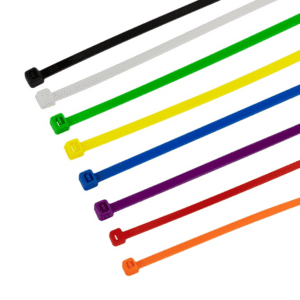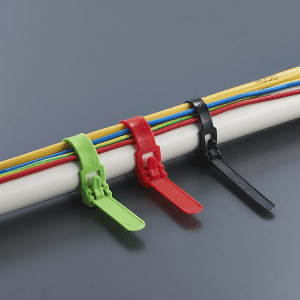- WhatsApp: 8613777772066
- Email: [email protected]
Whether you’re managing cables at home, setting up an office server, or tackling a large industrial wiring project, using the right cable management tools can make a massive difference. Among them, cable tie self locking products — often called self locking zip ties — offer one of the fastest and most secure solutions for bundling.
In this guide, you’ll learn everything about locking cable ties, including how they work, the different types available, and tips for choosing the best ones for your specific project.

A self locking cable tie is a one-piece fastener designed to secure wires, hoses, or tubing with minimal effort. These ties use a self-locking mechanism — as you pull the tail through the head, internal teeth grip it tightly, preventing loosening.
They’re widely used in electrical cable management, automotive repairs, network setups, and even gardening. Think of them as modern-day wire ties, but smarter and stronger.
Different jobs require different types of cable ties. Here’s a closer look at the most common options:
| Type | Material | Best Use |
| Self Locking Nylon Cable Ties | Nylon 66 | General indoor use, electronics |
| Stainless Steel Cable Ties | 304/316 steel | High heat, outdoor, marine environments |
| UV-Resistant Plastic Cable Ties | Nylon with stabilisers | Outdoor cable trays, signage |
| Heat-Resistant Locking Cable Ties | High-temp nylon or metal | Engine bays, factories |
| Heavy-Duty Self Locking Nylon Cable Zip Ties | Thick nylon or stainless | HVAC, large hose ties |
Some variants are also reusable cable ties, ideal for temporary installations or when frequent reconfiguration is needed.
Why do professionals and DIYers alike swear by self locking nylon cable ties? Let’s break it down:
Need something tougher? Choose stainless steel for a flame-resistant or anti-corrosive environment.

Releasable cable tie China Manufacturer
Correct usage ensures durability and safety. Follow this simple process:
Tip: For large-scale wiring setups, consider using a zip tie tensioning tool for consistent grip and professional finishes.
Once locked, most self tightening zip ties are non-reusable. Need to reconfigure? Use dedicated reusable cable ties instead.
Before buying, assess your environment and load:
Indoor vs. Outdoor: UV-resistant or stainless options for sun or water exposure.
Size & Strength: Check the cable diameter and select the right length and tensile rating.
Application Type: For electronics, go for self locking nylon cable zip ties; for plumbing or exhaust lines, choose metal.
Aesthetic Needs: Black or white ties for visual consistency in homes or displays.
Still unsure? Consult self locking cable tie suppliers or manufacturers who often provide spec sheets and recommendations for niche use cases.
You can buy these from major online platforms, but for consistent quality and reliable performance, it’s best to source from professional cable management tool suppliers or direct manufacturers.
Online marketplaces like Amazon or Alibaba
Electrical and hardware stores
Direct from self locking cable tie manufacturers for wholesale or OEM solutions
If you’re looking for high-quality, factory-direct self locking zip ties, feel free to contact our team.
As an experienced cable tie manufacturer, we offer a wide range of self locking nylon cable ties, plastic cable ties, and custom solutions that meet international certifications such as UL, CE, and RoHS. Whether you’re buying in bulk or need tailored support for a project, we’re here to help.
Get in touch with us today for competitive pricing, fast delivery, and expert guidance.
Q: Are self locking zip ties reusable?
A: Most aren’t. They’re designed for one-time, tamper-proof use. If you need flexibility, opt for reusable cable ties.
Q: Can I use self locking nylon cable zip ties outdoors?
A: Yes, but only if they’re UV-resistant or stainless steel — standard nylon may become brittle under sunlight.
Q: What’s the difference between plastic cable ties and self locking types?
A: All plastic cable ties aren’t self-locking. Self-locking types use an internal ratchet to prevent slippage.
Q: How do I cut a cable tie off safely?
A: Use flush cutters or scissors. Avoid twisting or pulling by hand to prevent injury or wire damage.
Q: Where can I find heavy-duty locking cable ties for industrial use?
A: Check with self locking cable tie suppliers or manufacturers offering industrial-grade or heavy-tensile products.
Whether you’re bundling wires in a cable tray, securing hoses in a car, or organising cords at your desk, self locking zip ties are a reliable, cost-effective solution. They’re durable, easy to use, and available in every size and strength you can imagine.
Next time you’re shopping for cable management tools, don’t underestimate the power of a good cable tie self locking solution — small tool, big difference.
Privacy Policy | Sitemap
Copyright BOESE Co.,Ltd SUPPORT BY :JUNJ